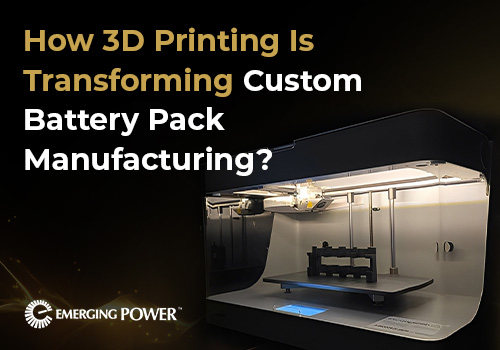Introduction
In today's competitive energy landscape, battery manufacturers in the USA are under pressure to deliver safer, smaller, and more efficient energy solutions—faster than ever. One innovation leading this shift is 3D printing manufacturing, also known as additive manufacturing. From rapid prototyping to next-gen solid-state battery designs, 3D modeling and 3D printing are unlocking new frontiers for custom battery pack production. In this blog, we’ll break down how 3D printing is shaping the future of Li-ion battery manufacturing, the top use cases, benefits, challenges, and what the road ahead looks like.What Is 3D Printing in Battery Manufacturing?
3D printing allows manufacturers to build components layer by layer from a digital model, creating complex geometries that traditional processes can’t easily match. In battery production, this includes:- Printed casings and pack enclosures
- Internal cooling structures for thermal regulation
- Custom cell layouts and curved or embedded housings
- Advanced solid-state components are printed directly
Top Emerging Use Cases for 3D Printing in Battery Packs
1. Solid-State / All-Printed Battery Cells
Researchers are 3D-printing entire battery cells—including electrodes and electrolytes—for safer, high-density solid-state batteries.2. Custom Conformal Designs
With 3D modeling, housings can be printed to match any device contour. Ideal for medical, wearable, and aerospace applications needing non-planar battery integration.3. Thermal Management Structures
Internal heat sinks, airflow channels, or porous lattices can be printed inside battery enclosures to control temperature, improving safety and lifespan.4. Rapid Prototyping
3D printing accelerates R&D cycles. No need for molds or tooling—just print, test, and iterate. This agility gives Li-ion battery manufacturers a significant go-to-market advantage.5. Integrated All-in-One Packs
Print casings, cooling, and connector features as one part—reducing assembly steps, weight, and complexity.Why It Matters for U.S. Battery Manufacturers
| Advantage | Impact |
| Design Flexibility | Custom geometries, shapes, and fit for specific devices |
| Performance Boost | Shorter ion paths, optimized electrodes, better heat regulation |
| Safety Improvements | Stronger enclosures, built-in cooling, fewer failure points |
| Cost & Waste Reduction | Less material waste, no tooling, fewer production stages |
| Faster Product Development | Rapid prototyping = faster innovation cycle and reduced time-to-market |
Key Challenges to Consider
- Material Compatibility: Not all battery materials (e.g., solid electrolytes) work well with current printing tech.
- Throughput at Scale: 3D printing lags in speed for high-volume EV pack production.
- Equipment Costs: High initial investment and expertise required.
- Post-Processing: Printing may still require curing, assembly, and finishing steps.
What’s Next: The Future of Battery Manufacturing with 3D Printing
- Fully Printed Batteries: Printing cells, enclosures, and connectors in one build
- Hybrid Production Models: Mixing 3D printing with CNC and injection molding
- New Printable Materials: Graphene, solid electrolytes, and nano-inks
- Standardization & Compliance: Evolving UL, UN38.3, and IEC standards to include 3D-printed components

